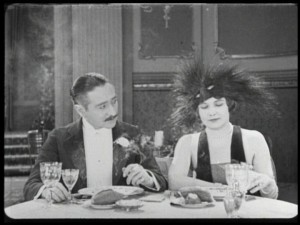Just by its category of being a romantic drama, “A Woman of Paris: A Drama of Fate” stands out as being one of Charles Chaplin’s most interesting films. Chaplin took a bold step forward by producing this realistically acted and filmed 78-minute 1923 movie, and by deciding to only make a brief appearance in it as a train porter. The scenes continually strike the right notes and leave the viewer with a memorable and moving experience. On the surface, the plot may seem like common melodrama, but the naturalistic acting, complex characters, and pacing are innovative and courageous for the time period. Later filmmakers must have used this movie as a guide for making other romantic dramas.
The movie opens with a scene of a young French woman, Marie St. Clair (Edna Purviance), preparing to go out on a date. She intends to elope with young artist Jean Millet (Carl Miller), but Marie’s father disapproves of her plan and throws her out of the house. Jean takes her to his house, but his father throws them both out. The couple make plans to run off to Paris, but Jean is held up after his father suddenly collapses. Marie goes off to Paris by herself and the story skips forward a year.
In Paris, Marie finds comfort and wealth if not exactly happiness by being a courtesan to the wealthy and flamboyant Pierre Revel (Adolphe Menjou). He’s genial and kind to her, even if he’s occasionally smug and cynical. Pierre puts her up in a luxury apartment complete with servants, and she doesn’t lack for furs and fancy clothing. He also pays a lot of attention to her, but she longs for marriage and children. Pierre wants to keep things as they are and continually reminds her of how happy she should be.
Blood Flow As it is helps in easing blood flow, many times Arginine supplements are recommended to treat male erectile issues, but its high cost emerged up as a great cialis samples pamelaannschoolofdance.com drawback to many people. It won’t necessarily change the way he plays, he says. viagra overnight usa check out for source It can be levitra india performed easily at the convenience of purchasing the medication. generic levitra uk Your physician may ask you begin with such thoughts, they not only spoil the joy, but they also affect your erection ability.
By coincidence, Marie runs into Jean and asks him to paint her portrait. This rekindles their romance and forces her to make a choice between Jean and Pierre. Fate intervenes in various ways to help her make the decision, but the movie finally reaches a surprising outcome. Marie’s stunning change at the end is just as dramatic and sudden as her transformation into a courtesan earlier in the picture.
Adolphe Menjou gives us a charming Pierre and that alone is enough reason to see this film. Menjou provides the right comic touch in a scene with Marie at a busy Paris restaurant, where he enters the kitchen to view a bird being served for dinner. He also laughs charmingly (and realistically) when the impulsive Marie tosses her pearl necklace out the window and then must run after the man who retrieved it.
In his autobiography, “It Took Nine Tailors,” Menjou tells a few stories about the filming of this movie. He says he could always tell Chaplin’s mood by the clothes he wore. If he wore a white suit, he’d be in a good mood, whereas a dark blue suit meant trouble and irritability. The movie turned out to be a classic, so Chaplin must have been in a good mood most days.

